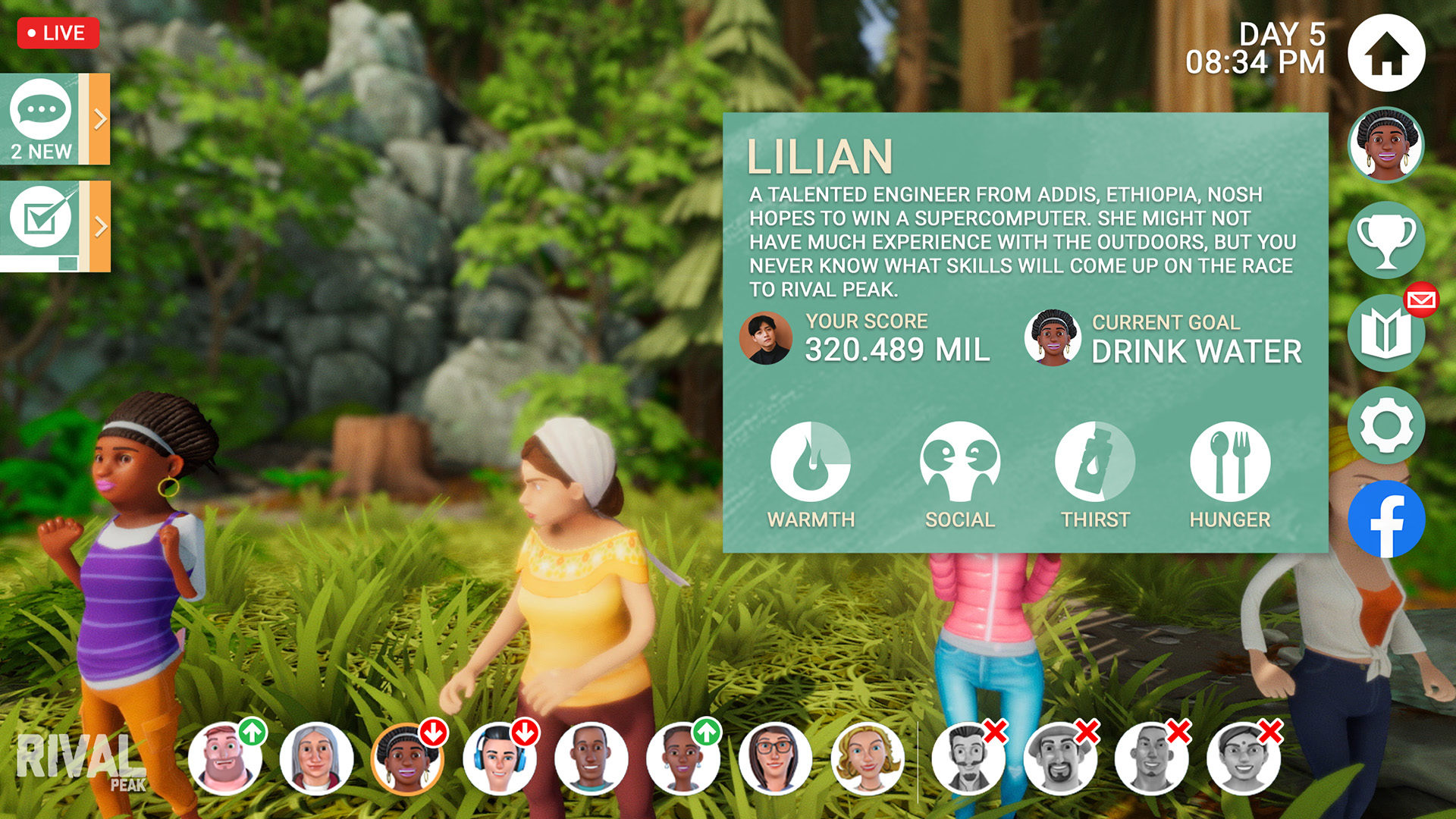By most traditional definitions, you’d be hard pressed to call Rival Peak a video game. Though it’s available through Facebook’s Instant Games platform, and though it does offer a measure of interactivity, your primary way to experience Rival Peak is by watching.
The team behind it uses the terms “serialized interactive narrative” and a “transmedia experiment,” but in practice it’s a bit more like a story-driven ant farm, or a digitized Survivor, or watching someone else play The Sims on Twitch. Needless to say, it’s a bit difficult to sum up in a few words.
Framed as a reality show–style competition, Rival Peak unfolds in a series of 24/7 livestreams, one for each of the 12 contestants. You can watch each of these virtual, AI-powered contenders in a simulation as they explore a mysterious island, trying to survive and gather clues to solve puzzles. Whoever reaches the top of the island’s mountain, we’re told, will win a $10 million prize. Viewers can vote to influence events of various impact, from whether a character prioritizes food, water, warmth, or socialization in its upcoming actions, to which contestant they’ll share secret info with. Watching and interacting with characters earns them points, which are necessary to survive the weekly eliminations.
The project, now in the eleventh week of a planned 12-week run, is a collaboration between the video game developer Pipeworks, streaming experts Genvid, and media company dj2 Entertainment, who might be best known these days for their hand in bringing Sonic the Hedgehog to the big screen last year.
“We had begun work on a really neat god game we thought could leverage an interactive streaming audience into active participants within our game,” explained Pipeworks studio design director Hal Milton. “We introduced it to Genvid, who had been advancing along their own track with a plan for dedicated interactive streaming tech that could be as deeply integrated into the client as it was agnostic about where those streams got served.
“We were lucky to find [dj2] after a creative hunt, and they really clicked with the story we wanted to tell about a reality TV show that convolutes itself into something much more,” he added.
Yes, all of Rival Peak’s passive and interactive elements feed into a larger narrative, the combined picture of which oozes complexity in a way that evokes Lost on steroids: a sinister conglomerate, mysterious brain scans, government research facilities, Soviet weapons, Native American mysticism, espionage, possession, astral projection.
Topping it off is the meta-layer that sells Rival Peak as an actual competition, complete with Rival Speak, a weekly, half-hour wrap-up show hosted by Wil Wheaton (who brings a surprisingly game energy to playing a frantic, increasingly malfunctioning simulation of himself). It’s a lot to take in—maybe a bit too much, if you’re not following the streams religiously. Still, given that the show is now nearing 100 million views, it’s clear that plenty of fans are enjoying the ride.

But more than the experience of watching (or play-watching, perhaps) Rival Peak, it’s the technology and artistic approach underpinning the project that’s of greatest interest to those of us who play traditional video games.
Powering each of Rival Peak’s contestants is an AI engine called FORNAP, short for First Order Regressive Numerical Action Planner. “Our proprietary AI is pretty neat in that it can freely—with no fixed decision tree—decide the best goal to pursue based on established desires/needs, use its abilities (including memory) to build a creative action plan to reach that goal, and even change its mind along the way due to live info it is taking in,” Milton explained. “It builds off of a number of great starting points but brings a level of dynamic creativity to bear that most game AI just doesn’t.”
The emergent nature of the technology has led to some memorable incidents during development. In a blog post on FORNAP’s development, Pipeworks’ senior software engineer Sol Sliwinski recounted that, in an earlier iteration of the tech, characters would resort to cannibalism when they got hungry. After all, other humans did contain meat, and they needed to eat. In an even more extreme incident, they tried to kill themselves to eat their own meat.
Though Rival Peak’s version of FORNAP has some constraints to stop these kinds of behaviors, that hasn’t stopped the entertaining discoveries—some of which have even been incorporated into the show. “Lead designer Greg Reinmuth discovered that if you put the brain of a wolf into one of our contestants it led to a hilarious game of chase,” Milton said. “We incorporated that into Rival Peak’s wacky story, and folks can actively vote to put wolf or feral brains into our contestants to see the harmless mayhem that ensues.”
Milton sees FORNAP as something that could enhance more traditional games across a number of genres, not just the god game that birthed it (and which Pipeworks still wants to make). “This AI can apply to any type of experience. We like to think of our planner solution as providing the foundation for believable individuals, groups, and less player-visible systems that can help direct the events of play in-real time based on live and historic player data. So, it’s pretty broadly applicable and scales to anything that needs to come with creative solutions for dynamically changing problems in a fun, emergent way,” he said.
Whether it’s a god game or a Skyrim-style RPG where every NPC has its own motivations guiding dynamic behavior, it’s easy to see how this systemic approach to character behavior might revolutionize any number of genres.

Consider the other half of Rival Peak—its semi-authored narrative—and the potential expands even further. In building out the story, dj2 landed “somewhere between a typical linear narrative and a fully generative one,” according to CEO Dmitri Johnson. In practice, that means that the writing team had overall goals for the story and its trajectory, which they used to define the personalities for the cast of characters. But they also observed the behaviors of those characters within the simulation, and then incorporated those elements into how they developed their personalities and roles within the story. One contestant named Saabun, for instance, would stare at trees. In the narrative, that reflects in his meditative, new-agey personality.
Since viewers can determine who stays and who goes home (well, it’s a little more complicated than that lately, but you get the drift), the team also had to account for a story where different characters may or may not be present.
According to Johnson, the team is able to accomplish this with a mix of planning and reactivity. “Our approach to accounting for eliminations involves some scripting that allows story-driven scenes to eliminate missing characters, or replace them with someone remaining, programmatically,” he explained. “Character-driven scenes for that character are eliminated. So it’s more like devising multiple alternatives in advance Telltale-style, but with optimizations to reduce wasted material that are motivated by our fiction. We also do have a writing team that is continuing to make minor adjustments based on audience-driven events—basically looking for any places where the up-front work has gaps and filling them. The TV show [Rival Speak] is structured in advance and revised ongoing until just before the shoot to account for events like eliminations.”
Whether it’s the (now patented) Nemesis system from the WB’s Middle-Earth games or Ken Levine’s concept of “narrative Legos,” it’s clear the gaming industry is looking for ways to tell different and more dynamic stories, and Rival Peak’s technology points to another potential way forward.
Throw in its adaptive narrative and the community-wide, unified storyline, and it’s easy to imagine incredibly ambitious developments in MMOs or live-service games, too. If you’re old enough, you might remember the days when The Matrix Online held massive, world-altering events in game. (Younger readers might better appreciate the similar stunts Fortnite has pulled.) But an experience that merges that evolving narrative approach and the actions and interactions of players with independent-minded AI actors could clearly take the concept to ridiculous new heights. With the increasing prevalence of cloud computing in the gaming space—beyond simple streaming platforms, look at games like Microsoft Flight Simulator—it’s no longer impossible to imagine.
For more than a decade now, technical advancements in games have mostly been about upping the polygon count and resolution, with fancy new graphical effects tacked on. Real revolutions—in the sorts of games we play and how we play them—have been fewer and further between. (Virtual reality may be the exception to that rule, but its appeal and staying power are still uncertain, to say the least.) The experimental work Pipeworks is doing, though, proves that there’s plenty of territory that games—even those confined to a screen—have still yet to explore. In the coming years, we may once again return to the days when new gaming experiences constantly redefine our expectations of what the medium can be.
And if we do reach that lofty mountaintop, the quirky, category-defying Rival Peak will have to be remembered as a step on the way.
